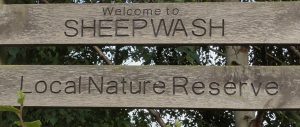Section 106 money spent on Sheepwash Local Nature Reserve
BACKGROUND
These two requests relate to Sheepwash Local Nature Reserve which achieved this status in 2000. Formally it was known as “Sheepwash Urban Park” after being developed in the early 1980’s and was reclaimed from part of a former council refuse tip and also in part the former pumphouse brickworks. It lies less than 100 metres away from Rattlechain lagoon and is linked by a track- the continuation of John’s Lane underneath the West Coast mainline railway and the Birmingham Mainline canal.

The River Tame runs through the site. Above the goose you can see the entrance to John’s Lane tunnel. Above that The Birmingham Mainline canal.
The site attracts both human and wildlife visitors and is the largest single Nature Reserve site in the borough of Sandwell. Unlike Rattlechain it is open space all year round. Due to its former uses, the site underwent landfill gas monitoring- primarily for methane.
As part of the planning system, section 106 money is contributed by developers to sites specified by local authorities. Several developments in the Great Bridge area resulted in Sheepwash and the Haines Branch Walkway being allocated this money for both Capital and Revenue budgets. The Haines Branch Walkway runs adjacent to Sheepwash and is a former abandoned canal, now incorporating the River Tame. A decision was by the council to allocate money set aside for both sites to Sheepwash, given that the former canal had an additional new build planned nearby. Unfortunately this stalled when the developer went into liquidation.
- We have a long established interest in this site. We wanted a breakdown of money spent on the site.
- We also wanted to know what gas monitoring the council had implemented – especially given the associations with Rattlechain’s own potential gas generation both in the past and the future, and not least the merits of spending such a large amount of public money on a site that could become a liability if toxic gases were found to be being generated.
WHAT DID WE ASK?
With regard to the money allocated to be spent on Sheepwash
The following monies were allocated through section 106 planning agreements to Sheepwash and Haines Branch
DC/05/44165 £87,288.90
DC/05/43840 £I69,597.76
DC/03/41538 £122,637.52
DC/02/39921 £49,421.79
DC/02/39480 £52,775.00
TOTAL = £ 481,720.97
I am seeking a year by year spend of what money has been spent on Sheepwash Nature Reserve from this money in terms of both capital and revenue expenditure.
I would also like a breakdown of what this money has funded at the site, including fees for landscape architects work.
I would like this information in excel spreadsheet form
The council responded. Two excel spreadsheets were supplied with a breakdown of capital and revenue cost spend.
WE OBSERVE
On this point it could be argued as to whether spending over £30,000 on landscape architect fees alone represents good value for money. On walking around the site today since this request was made, it is difficult to comprehend where all of this public money has been spent. Legally binding agreements meant that it could not be spent on any other site without agreement from the developers. We feel that this matter should have received scrutiny from the councillors at this local authority.
The second request concerned monitoring of gas at the reserve. We received a response from the council and their replies are given below. They are certainly economic with words!
(i)Could you confirm what gas monitoring measures are in place at Sheepwash Local Nature Reserve , Great Bridge Tipton and who undertakes the monitoring on behalf of Sandwell Council and how frequently this is performed?
Gas monitoring is not currently being undertaken at this site.
(ii) If possible and within the cost limits could you show by way of a map of the site, where the monitoring points are at the site?
This site was last monitored for landfill gas in 1996 and it is most unlikely that the monitoring points in use at that time will have survived.
(iii) Could you confirm the most recent results undertaken and whether and how past monitoring results can be viewed by members of the public?
The most recent results are from samples submitted on 14 October 1996 which were analysed for methane, carbon dioxide, oxygen and nitrogen. Sampling was undertaken at that time to check the performance of a perimeter vent trench and slurry wall which had been installed to prevent landfill gas migration from the infilled marl hole. Long-term monitoring had by that date established that the gas control measures were effective and testing was then discontinued. Periodic maintenance is now undertaken on the vent trench to ensure it does not become overgrown or silted-up. Specific results are not published but could be requested under the Environmental Information Regulations 2004.
(ii) Can you confirm that phosphine gas levels have never been tested for or undertaken at the site during any part of it’s development or since 1974 with the creation of Sandwell council, and that the council have never asked anyone to undertake such
analysis?
There are no records within this organisation of any testing for phosphine or of any requests for such testing to be undertaken.
WHAT DOES THIS MEAN?
Taking these two requests together, it can be seen that a great deal of money can be spent on a site that was once a council tip. With landscaping and a little care, this provides a much better resource than mass house building over derelict land. The gas monitoring of this site however appears to be non specific for phosphine from an adjacent site which could threaten the existence of it in the future.


